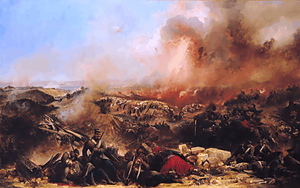John Taylor (VC)
| John Taylor | |
|---|---|
|
Depiction of the Siege of Sebastopol | |
| Born |
1822 Bristol, Gloucestershire |
| Died |
25 February 1857 (aged 34–35) Woolwich, London |
| Buried at | Woolwich cemetery |
| Allegiance |
|
| Service/branch |
|
| Rank | Captain of the Forecastle |
| Battles/wars |
First Anglo-Chinese War Crimean War Second Anglo-Burmese War |
| Awards |
Victoria Cross Conspicuous Gallantry Medal Légion d'honneur (France) |
John Taylor VC, CGM (1822 – 25 February 1857) was a sailor in the Royal Navy and an English recipient of the Victoria Cross, the highest award for gallantry in the face of the enemy that can be awarded to British and Commonwealth forces.
Details
Taylor was about 33 years old, and a captain of the forecastle in the Royal Navy, serving in the Naval Brigade, during the Crimean War when the following deed took place for which he was awarded the VC.
On 18 June 1855 in the Crimean Peninsula, immediately after the assault on Sebastopol, a soldier of the 57th Regiment, who had been wounded in both legs, was observed sitting up and calling for help. At once the second-in-command (Henry James Raby) of the scaling party, another seaman (Henry Curtis) and Captain of the Forecastle Taylor left the shelter of their battery works and ran forward a distance of 70 yards, across open ground, through heavy gunfire and succeeded in carrying the wounded man to safety.[1]
Further information
John Taylor's Cross is currently held in the Sheesh Mahal Collection in Patiala, India. The group formed part of the Maharaja Bhupendra Singh's collection, which was bequeathed to the Museum on the death of the Maharajah's son in 1947, and consists of the VC, Conspicuous Gallantry Medal (1st type), China War Medal 1842, India General Service Medal 1854 clasp Pegu, Crimea Medal clasps Inkermann and Sebastopol, Légion d'honneur and Turkish Crimea Medal.
John Taylor was buried in Woolwich cemetery in southeast London.
References
- ↑ The London Gazette: no. 21971. p. 653. 24 February 1857. Retrieved 29 March 2015.
- Monuments to Courage (David Harvey, 1999)
- The Register of the Victoria Cross (This England, 1997)
External links
- Location of grave and VC medal (S.E. London)
